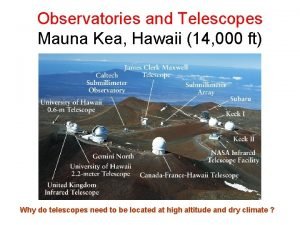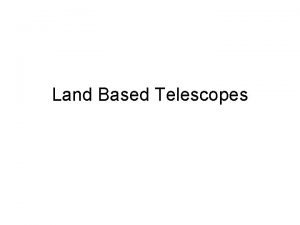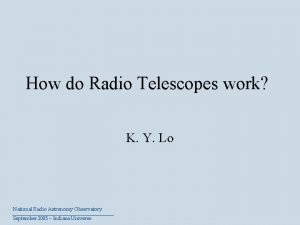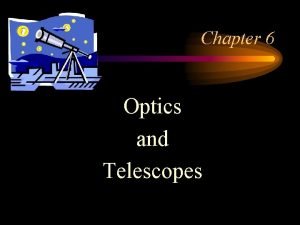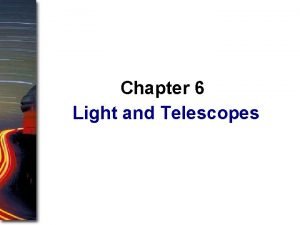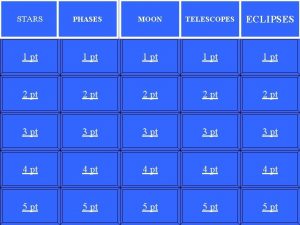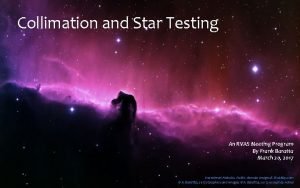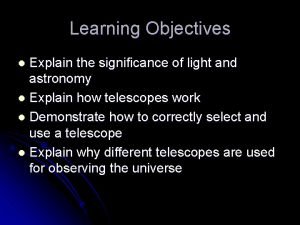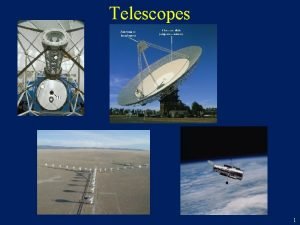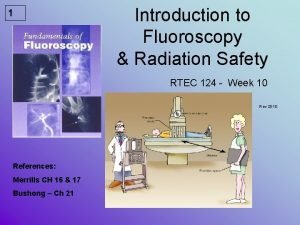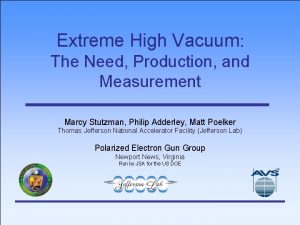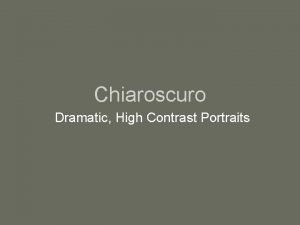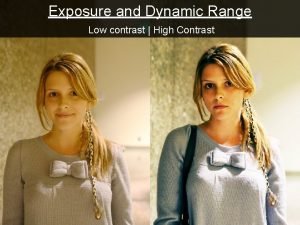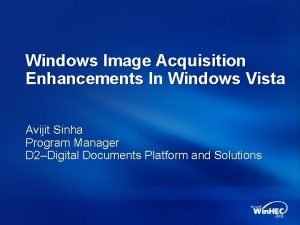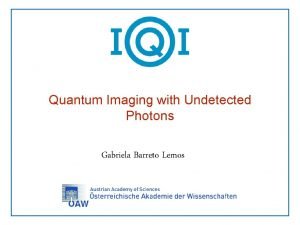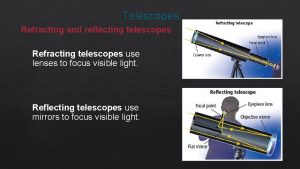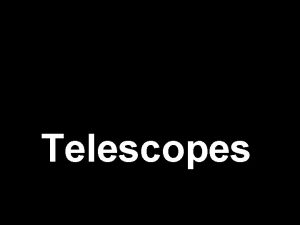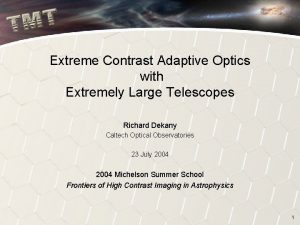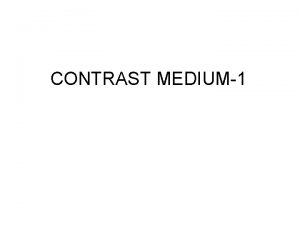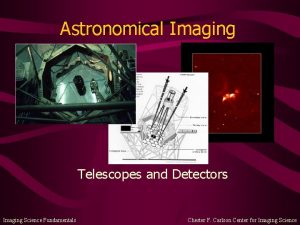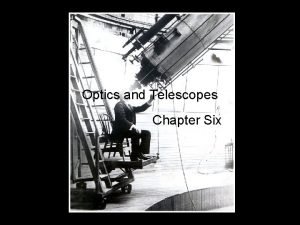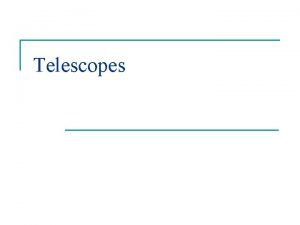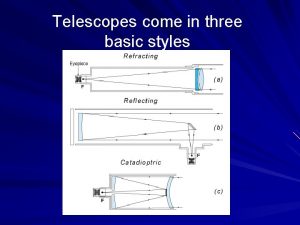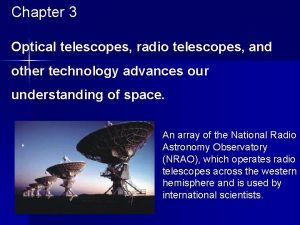High Contrast Imaging Extreme AO 30 m Telescopes




















- Slides: 20

High Contrast Imaging Extreme AO & 30 -m Telescopes James R. Graham UC Berkeley 2005/02/16 1

High Contrast Imaging • Solar observations with a Lyot coronagraph SOHO C 3 coronagraph • SOHO • Coronal mass ejections & sun-grazing comets • Planet detections! 16° 2 http: //sohowww. nascom. nasa. gov

High Contrast Imaging • Stellar coronagraphs Smith & Terrile 1984 Science 226 1421 • Discovery of scattered light disk— Pictoris • Brown dwarfs—GD 229 B Nakajima et al. 1995 Nature 378 463 3

State of the Art • Fomalhaut debris disk F 606 W + F 814 W HST/ACS coronagraph Kalas Clampin & Graham 2005 Nature, Submitted – µ ≈ 20 mag arc sec-2 – µ/µ 0 ≈ 10 -10 • Hard-edged Lyot coronagraph – Contrast is limited by quasi-static wavefront errors • Speckle noise 4

Utility of High Contrast Imaging • Broad potential scientific application – Exoplanet detection – Circumstellar disks • Proto-planetary & debris disks – Fundamental stellar astrophysics • Stellar binaries – Mass transfer & loss • Cataclysmic variables, symbiotic stars & supergiants – Solar system: icy moons, Titan, & asteroids 5

Exoplanet Science • Doppler surveys have cataloged 137 planets – Indirect searches are hindered by Kepler’s third law • PJupiter = 11 years • PNeptune = 165 years • A census of the outer regions of solar systems (a > 10 AU) is impractical using indirect methods • 1/r 2 dimming of reflected light renders TPF-C insensitive to planets in Neptune orbits • Ex. AO is sensitive to self-luminous planets with semimajor axes 4– 40 AU 6

Architecture of Planetary Systems • 137 Doppler exoplanets – 5% of targeted stars possess massive planets – Lower limit on occurrence of planets – Abundance of solar systems—why isn’t it 15 to 50%? • A diversity of exoplanet systems exist… • ≤ 20% of the solar system’s orbital phase space explored – Is the solar system typical? • Concentric orbits & radial sorting – What are the planetary systems of A & F stars? – How do planets form? What dynamical evolution occurs? • Core accretion vs. gravitational collapse • Planetary migration • Doppler surveys raise new questions – What is the origin of exoplanet dynamical diversity? 7

Architecture of Planetary Systems • Direct imaging is “instant gratification” – Fast alternative to Doppler surveys • Improved statistics (4– 40 AU vs. 0. 4– 4 AU) – Worst case, d. N/d log(a) ~ const. – Oligarchy, d. N/d log(a) ~ a – Searching at large semimajor axis • Sample beyond the snow line • Characterize frequency & orbital geometry > 4 AU – Is the solar system is unique • Reveal the zone where planets form by gravitational instability (30– 100 AU) • Uncover traces of planetary migration – Resolve M sin(i) ambiguity 8

Cooling Planets • Contrast required to detect a cooling planet is much less in the near-IR than in the visible – Radiation escapes in gaps in the CH 4 and H 2 O opacity at J, H, &, K Burrows Sudarsky & Hubeny 2004 Ap. J 609 407 9

What is Ex. AO • How can we achieve contrast Q < 10 -7? • Control of wavefront errors – Wavefront errors, , cause speckles which masquerade as planets • 2 ≈ (Q/16) D 2 [ 22 - 12] on spatial frequencies 1/ < f < 2/ • = 3 nm rms for Q = 10 -7 between 0. ” 1 < < 1” (30 cm to 300 cm) • Control of diffraction – Need AO & a coronagraph because wavefront errors and diffraction couple 10

Wavefront & Diffraction Control 64 /D • Focal plane simulations for Gemini Ex. AO at H – The dark hole shows the control radius /2 d • Increasing contrast due to suppression of speckle pinning Circular pupil Lyot coronagraph APLC Remi Soumier 11

It’s Not About Strehl • 70 nm RMS dynamic wavefront error 0 nm 2 nm – S = 0. 93 • 0 , 2, & 4 nm RMS static wavefront error – Strehl ratios differ by less than 10 -4 – Systematic errors prevent detection of the exoplanet 5 MJ 1 Gyr exoplanet • Atmosphere has ‹ ›=0 – Not crazy to do this from the ground 4 nm 12 Bruce Macintosh

Ex. AO Science on 8 -m Telescopes • Ex. AOC on 8 -m telescopes can yield the first detections of self -luminous exoplanets 13

Ex. AO Science on 8 -m Telescopes • Probe beyond the snow line – Complementary to Doppler & astrometric searches Doppler 8 -m Ex. AO 14

Ex. AO Science on 8 -m Telescopes Ag e H 2 O NH 3 Ma ss • First reconnaissance of planetary atmospheres Jupiter 15 Ex. AO T dwarfs

8 -m vs. 30 -m • Better angular resolution • Better contrast HST – For a given rms wavefront error budget (on fixed spatial scales) Gemini Ex. AOC TMT? Jovian reflected light • TMT can’t lock on fainter guide stars! TPF-C? 2 = 1. 0 arc sec 1 = 0. 1 arc sec 16

TMT Science: What 8 -m’s Can’t Do • Detect Doppler planets – /D is too big to find planets in 5 AU orbits – Inner working distance of TMT is three times smaller • Reflected light Jupiters – Q ≈ 2 x 10 -9 (a/5 AU)-2 – TMT could make old, cold planets a priority – Redundant with TPF-C and indirect searches? 17

TMT Science: What 8 -m’s Can’t Do • Explore star forming regions – Taurus, Ophiuchus &c. are too distant – TMT can work into 5 AU • Intermediate contrast Q ≈ 10 -6 at increased angular resolution (10 mas at H) is valuable – Planet forming environment – Evolved stars and stellar mass loss 18

TMT Science: What 8 -m’s Can’t Do • Astrometry – Detection of exoplanet orbital acceleration requires astrometric precision of about 2 mas (about 1/10 of a pixel for an 8 -m) – Ultimate goal is to measure Keplerian orbital elements, especially e – Angular resolution of TMT is major benefit for TMT • Spectroscopy of exoplanet atmospheres – Rudimentary Teff , log (g) measurements at R ≈ 40 are feasible with an 8 -m – TMT can study composition of exoplanet atmospheres, especially important to understand the condensation of H 2 O and NH 3 clouds 19

The Path to Ex. AO TMTs • 104 actuator deformable mirrors • 5122 fast (k. Hz), low noise (few e-) CCDs • Fast wavefront reconstructors – FFT algorithms • Segment errors & discontinuities must be factored into the wavefront error budget – Discontinuities are OK, so long as the wavefront sensor is band-limited – AO controls wavefront errors, but not diffraction – Unobscured, filled aperture is ideal… • Large gaps render apodization problematic • Uniform reflectivity 20
 Frc driver station mac
Frc driver station mac Extreme wide shot vs wide shot
Extreme wide shot vs wide shot A building that contains one or more telescopes
A building that contains one or more telescopes Chromatic aberration affects reflector telescopes.
Chromatic aberration affects reflector telescopes. Land based telescopes
Land based telescopes Computer controlled telescopes
Computer controlled telescopes How do radio telescopes work
How do radio telescopes work Modern telescopes make it possible for astronomers
Modern telescopes make it possible for astronomers All modern large optical telescopes are refractors.
All modern large optical telescopes are refractors. Guidepost of light
Guidepost of light New moon telescopes
New moon telescopes Star testing telescopes
Star testing telescopes Telescope history timeline
Telescope history timeline Significance of light
Significance of light How do telescopes work
How do telescopes work Double contrast vs single contrast
Double contrast vs single contrast Extreme high vacuum
Extreme high vacuum Chiaroscuro definition
Chiaroscuro definition High low contrast
High low contrast What is windows image acquisition
What is windows image acquisition Gabriela barreto lemos
Gabriela barreto lemos



